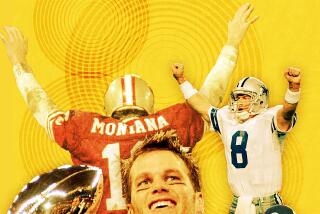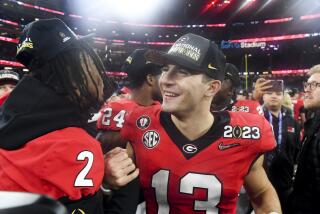41% in NFL Graduate From College : Rate in Pacific 10 Conference Only 38%, Report Shows
- Share via
Six of every 10 players in the National Football League have failed to earn their college degrees, even though most of these former collegiate stars attended American universities as full-time students for four or five years, a Dallas Times Herald study of NFL graduation rates has determined.
A computer analysis of the biographical records of 1,542 professional athletes on the rosters of the NFL’s 28 teams at the start of 1985 training camps reveals that only 41% graduated from the colleges they attended. This study also shows that 33% of the league’s black players completed degrees. Nearly 50% of white players graduated.
In Super Bowl XX, the Chicago Bears lined up with a graduation rate of about 52%--the fifth-best in the NFL--while the New England Patriots sported a graduation rate of about 36%, the ninth-lowest in the league.
The overall impression emerging from the Times Herald study is that a majority of NFL players excelled on the field but produced sub-standard performances in the classroom.
“It’s not real surprising to me,” said Tex Schramm, president and general manager of the Dallas Cowboys football team, which collectively produced a 47% graduation rate--the eighth-highest in the NFL. “I know that you hear of players who say they are going back to school--and a few do. But a large number don’t.”
The graduation rate of the current class of professional football players offers a look at the respective successes and failures of the American post-secondary school system as it educates many of the country’s most avidly recruited athletes.
On average, the Times Herald analysis shows, NFL athletes graduated at a rate 10 to 30 percentage points below the graduation rate for American college students at large, even though many of the players were on full athletic scholarships throughout their college careers.
The low graduation rate for blacks is particularly daunting for educators, who say that it hints at the continued failure of the American secondary and post-secondary school system to equally educate members of all races. Black athletes in the NFL graduated at a rate 20% to 40% below the national student average.
Moreover, various collegiate officials and NFL player representatives say that they believe that the NFL player graduation rates are probably even lower than the study suggests.
“I hope your figure is right, but I’m afraid the (graduation) information you’re getting is when a player sits down with the team’s P.R. department and fills out a survey,” observed Mark Murphy, a former player for the Washington Redskins and now assistant to the executive director of the National Football League Players Assn. “You probably have a situation where a player doesn’t want them to think he hasn’t graduated and so he checks off ‘graduated.’ Everything I’ve ever seen has suggested about a one-third (33% NFL) graduation rate.”
Whether or not a player graduated seems to be connected statistically to the length of that player’s career and may even relate to the chronic problem of drug abuse among many NFL players, according to Murphy. Athletes with degrees play on average one year longer than players without degrees, he noted. With NFL player salaries averaging $195,000 annually, this translates into powerful economics over an athlete’s short career, which typically lasts only 4 1/2 years, NFL officials say.
The low graduation rate for professional football players also raises nettlesome questions among educators concerning the exploitation of college athletes, who by and large are required to play out four years of college eligibility before they can try out for the NFL.
In exchange for playing four years on university teams, student athletes should receive a solid education, culminating with the award of a formal degree, educators say. This is not happening for many of the nation’s best football players.
What’s more, some education officials note, hundreds of thousands of dollars in the form of scholarships are wasted on athletes who attend college not because they desire an education, but because it is the only sanctioned stepping stone to the pros. In effect, these critics charge, American colleges and universities have become the NFL’s minor league training grounds.
Other findings from the study include:
--Many of the large college conferences recorded graduation rates among their alumni playing professional football that fell well below the NFL average. The Big 8, Southeast and Pacific 10 conferences respectively posted graduation rates of 34%, 34% and 38%.
--USC, with 46 NFL-caliber alumni, was the greatest single collegiate spawning ground of professional football players. Fifty percent of the USC players had graduated.
--The University of Texas at Austin, with 37 former players on NFL rosters, had the third-greatest number of alumni in the league; 43% of them had degrees.
--California, as a home state where players attended high school, had produced more active NFL players--235--than any other state. However, the graduation rate for these players was only 32%.
--The Cleveland Browns, the AFC Central champions this season, had the highest graduation rate in pro football at 64%. By national standards, about half the students entering college graduate within four years, noted Dennis Carroll, a researcher at the U.S. Department of Education’s Center for Statistics. Other studies show that the national graduation rate climbs as high as 70% when students remain in college six or seven years.
Nearly all the professional players in the study had passed beyond the five-year benchmark from the time they entered college.
The below-average graduation rate among NFL players was no surprise to those familiar with the world of professional football.
“It is consistent with some of the figures that I have seen previously,” said Joe Brown, communication director of the National Football League. NFL Commissioner Pete Rozelle was not available for comment, Brown said.
The issue of education is especially poignant for black athletes, who have graduation rates strikingly lower than those of white athletes. In the Southwest Conference, for instance, the spread between black and white graduation rates was 27 percentage points.
This gap, educators say, is a reflection of the long-standing disparity in academic preparation among different ethnic groups in the United States and may hint at the exploitation of athletes in general and blacks in particular. Many athletes are quietly taught to believe that their athletic abilities will be their ticket to fame and fortune, replacing the need for a thorough academic education, which traditionally helps prepare a young person for a career.
In fact, the dream of playing in the big leagues eludes most young men. The odds are 12,000 to 1 that a high school athlete will make it to the pros in either football or basketball, said Richard Lapchick, director of Northeastern University’s Center for the Study of Sport in Society.
There seems to be no silver lining in this cloud hanging over the NFL. Some educators contend, as does the NFLPA’s Murphy, that the actual NFL graduation rates are inflated. As evidence, they point to studies such as one recently completed in the University of North Carolina’s 15-school statewide system. The results of this intercollegiate athletics study were daunting.
North Carolina discovered that student athletes on full scholarships often graduated at about half the rate of the general student body, noted Arthur Padilla, associate vice president for academic affairs for the University of North Carolina system.
“What we found is that graduation rates of athletes, especially in the revenue sports, were significantly below the rates for students at large in the institutions,” Padilla said.
“I don’t believe the (NFL) graduation rate is 41%--41% sounds too high,” insisted Padilla, who said that the average student athlete graduation rate at several of his state’s schools was only about 20%.
A growing number of educators like Padilla have begun to sound alarms. They contend that the undue influence accorded to revenue-producing sports such as football and basketball has begun to subvert the larger educational system. The most talented athletes are marked as a special class of students, who often are admitted with academic qualifications that would be inadmissible in other applicants to the same universities. Once admitted, these athletes are occupied full-time training for and competing in their sports.
“In the schools where we’re talking about big-time sports, a lot of kids are admitted who really can’t do the work of that institution,” said Ed Wall, a former director of admissions at USC. “They are brought in and just dumped.”
More to Read
Go beyond the scoreboard
Get the latest on L.A.'s teams in the daily Sports Report newsletter.
You may occasionally receive promotional content from the Los Angeles Times.










